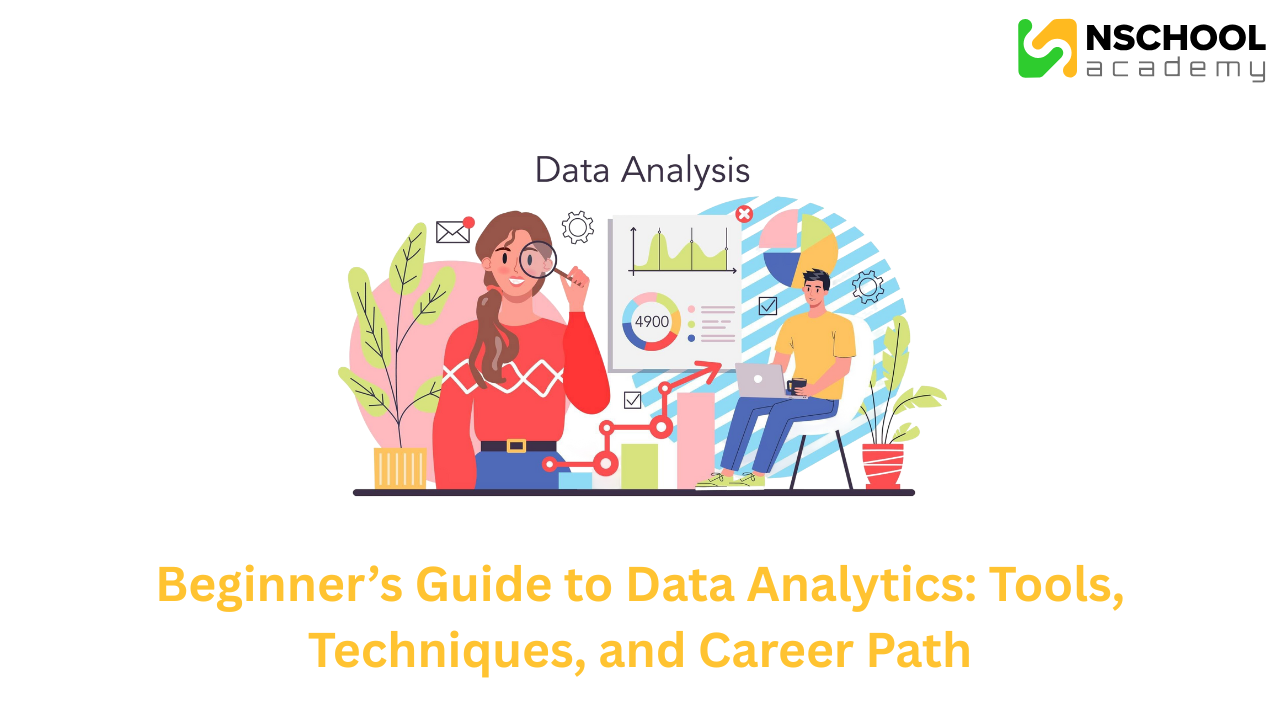Beginner’s Guide to Data Analytics: Tools, Techniques, and Career Path
- October 22, 2025
- nschool
- 0

Beginner’s Guide to Data Analytics: Tools, Techniques, and Career Path
In today’s data-driven world, every click, purchase, and online interaction generates valuable information. Businesses use this information to make smarter decisions, improve customer experiences, and stay ahead of competitors. This process of collecting, analyzing, and interpreting data is known as data analytics.
If you’re new to this field and wondering how to get started, this guide will walk you through the basics of data analytics, the tools and techniques used, and how you can build a successful career in this exciting domain.
What Is Data Analytics?
Data analytics is the science of examining raw data to uncover patterns, correlations, and insights that can help organizations make informed decisions. It’s not just about crunching numbers — it’s about finding meaning and value in data.
For example, e-commerce platforms analyze purchase behavior to recommend products, while hospitals study patient data to improve treatment outcomes. Data analytics is everywhere, from marketing and finance to healthcare and sports.
Types of Data Analytics
There are four core types of data analytics: Descriptive, Diagnostic, Predictive, and Prescriptive.
- Descriptive Analytics – Answers “What happened?” by summarizing historical data. Example: monthly sales reports.
- Diagnostic Analytics – Explains “Why did it happen?”“by identifying trends and connections in the data.”
- Predictive Analytics – Predicts “What could happen?” using machine learning and statistical models.
- Prescriptive Analytics – Suggests “What should we do?” by recommending actions based on data insights.
Understanding these types helps analysts decide which approach to use depending on the business goal.
Essential Tools in Data Analytics
Data analysts use various tools to gather, clean, and visualize data effectively. Here are some of the most popular ones for beginners:
- Microsoft Excel – A fundamental tool for data entry, calculations, and creating pivot tables. Great for small-scale data analysis.
- Google Sheets – Cloud-based and ideal for collaborative data analysis.
- SQL (Structured Query Language) – Used to extract and manage data from databases efficiently.
- Python – A powerful programming language with libraries like Pandas, NumPy, and Matplotlib for advanced data manipulation and visualization.
- R Programming – Specially designed for statistical analysis and visualization.
- Power BI / Tableau – Business intelligence tools that turn raw data into interactive dashboards and visual stories.
Mastering these tools can help beginners build a strong foundation and handle real-world datasets confidently.
Key Techniques Used in Data Analytics
To become a successful data analyst, you need to understand and apply core analytical techniques:
- Data Collection and Cleaning – Gathering data from different sources and removing errors or inconsistencies. Clean data ensures accurate insights.
- Data Visualization – Presenting data through charts, graphs, and dashboards to make it easier to interpret. Tools like Tableau and Power BI are perfect for this.
- Exploratory Data Analysis (EDA) – Identifying trends, outliers, and relationships in the data.
- Statistical Analysis – Applying statistical methods to validate patterns and relationships within datasets.
- Predictive Modeling – Using algorithms to forecast future trends based on historical data.
- Reporting – Communicating findings effectively through visual reports and summaries to help management make data-driven decisions.
These techniques transform data from mere numbers into actionable business intelligence.
Applications of Data Analytics
Data analytics plays a crucial role across multiple industries:
- Marketing: Understanding customer behavior, measuring campaign performance, and personalizing content.
- Finance: Detecting fraud, assessing risks, and improving investment strategies.
- Healthcare: Enhancing patient care through predictive diagnosis and treatment analysis.
- Retail: Managing inventory, setting prices, and predicting customer demand.
- Sports: Analyzing player performance and optimizing team strategies.
No matter the industry, data analytics helps organizations work smarter and make more informed choices.
Steps to Start a Career in Data Analytics
If you want to become a data analyst, follow these steps:
- Learn the Basics of Statistics and Mathematics
A solid understanding of probability, averages, and statistical models is crucial. - Develop Technical Skills
Gain hands-on experience with tools like Excel, SQL, Python, and visualization platforms. Online tutorials and certification courses can help. - Work on Real Projects
Practice with open datasets (like Kaggle) to apply your skills and build a portfolio. - Understand Business Problems
Data analysis isn’t just about technical work — it’s about solving business challenges. Try to understand how data drives business decisions. - Create a Strong Resume and LinkedIn Profile
Highlight your projects, certifications, and analytical achievements. - Apply for Internships or Entry-Level Jobs
Gain practical experience in real-world environments. Roles like Data Analyst, Business Analyst, or Reporting Analyst are great starting points. - Keep Learning and Evolving
Data analytics is a dynamic field. Stay updated with new tools, techniques, and trends such as AI and machine learning.
Career Opportunities in Data Analytics
As organizations increasingly rely on data, the demand for skilled data professionals is skyrocketing. Some popular career roles include:
- Data Analyst – Collects, processes, and interprets data to help companies make informed decisions.
- Business Analyst – Connects data findings with business goals for better decision-making.
- Data Scientist – Builds predictive models and uses machine learning for deeper insights.
- Data Engineer – Designs and maintains data systems and pipelines.
- BI Analyst (Business Intelligence) – Focuses on creating dashboards and reports to track performance.
According to global surveys, data analytics jobs are among the fastest-growing and most rewarding, offering excellent pay and opportunities to work across industries.
Future of Data Analytics
The future of data analytics is promising. With advancements in artificial intelligence (AI), machine learning (ML), and big data, the demand for professionals who can interpret and visualize complex datasets will continue to grow.
Businesses will rely more on real-time analytics to make quick, data-backed decisions. Moreover, industries like cybersecurity, environmental science, and education are also adopting analytics to improve efficiency and outcomes.
Conclusion
Data analytics is not just a career — it’s a gateway to understanding how the world operates through data. Whether you aim to work in business, healthcare, or technology, the ability to analyze and interpret data will always be a valuable skill.
By mastering the right tools, techniques, and analytical mindset, you can transform raw data into meaningful insights and build a rewarding career in one of the most in-demand fields today.
FAQ
1. What is data analytics, and why is it important?
Data analytics is the process of examining raw data to uncover useful information and trends. It helps businesses make smarter decisions, improve performance, and predict future outcomes based on data insights.
2. Do I need coding skills to start a career in data analytics?
Not necessarily. Beginners can start with tools like Excel or Power BI. However, learning programming languages like Python or SQL can help you advance to more complex data analysis roles.
3. Which tools are best for beginners in data analytics?
Some beginner-friendly tools include Excel, Google Sheets, Tableau, Power BI, and SQL. Once you’re comfortable, you can move on to programming tools like Python and R.
4. What qualifications do I need to become a data analyst?
A degree in computer science, mathematics, statistics, or economics is helpful, but not mandatory. Many professionals enter the field through online courses, certifications, and hands-on project experience.
5. What is the average salary for a data analyst?
Salaries vary by country and experience, but entry-level data analysts can expect competitive pay. With experience and advanced skills, professionals can earn higher salaries in roles like Data Scientist or BI Analyst

